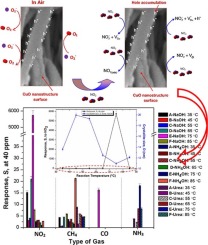Sensors and Actuators B: Chemical ( IF 8.0 ) Pub Date : 2018-03-19 , DOI: 10.1016/j.snb.2018.03.106 D.N. Oosthuizen , D.E. Motaung , H.C. Swart

|
The strategy for the synthesis of metal oxide nanostructured based sensors that operate at room temperature with higher sensitivity and selectivity facilitates the forecasts towards low cost and power consumption gas sensors which will be beneficial to domestic and industrial applications. As a result, herein, we report on the improved room temperature NO2 gas sensing based on CuO nanostructures grown using the sonochemical method in various aqueous solutions. A transformation of the copper nitrate solution under basic aqueous conditions into CuO nanoplatelets and flower-like nanostructures, without the assistance of any surfactants and additives was observed. Structural analyses revealed a size–dependent broadening due to the decrease in platelet size as the reaction temperature was increased. A high sensitivity of 173 ppm−1 and selectivity to NO2 gas at room-temperature has been realized when using NaOH as a base. The higher sensing properties were due to longer synthesis reaction temperature (75 °C), resulting to small crystallite size, higher Brunauer-Emmett-Teller surface area and point defects.
中文翻译:

超声化学法制备的基于CuO纳米片的室温NO 2气体传感器的深入研究:各种碱的比较
在室温下以更高的灵敏度和选择性运行的基于金属氧化物纳米结构的传感器的合成策略,促进了对低成本和低功耗气体传感器的预测,这将有利于家庭和工业应用。结果,在此我们报告了室温NO 2的改善基于在各种水溶液中使用声化学方法生长的CuO纳米结构的气体传感。观察到在没有任何表面活性剂和添加剂的帮助下,硝酸铜溶液在碱性水溶液条件下转变为CuO纳米片和花状纳米结构。结构分析表明,随着反应温度的升高,血小板大小的减小会导致大小相关的加宽。当使用NaOH作为碱时,已经实现了173ppm -1的高灵敏度和在室温下对NO 2气体的选择性。较高的感测性能是由于较长的合成反应温度(75°C),较小的微晶尺寸,较高的Brunauer-Emmett-Teller表面积和点缺陷引起的。









































 京公网安备 11010802027423号
京公网安备 11010802027423号